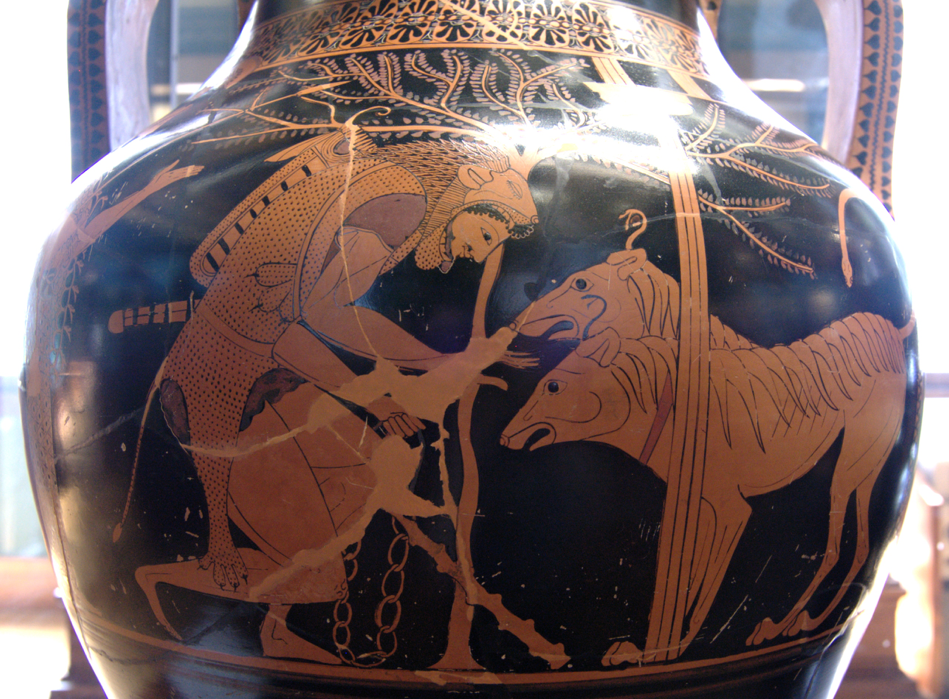The Twelve Labors of Heracles
As a punishment for the murder of his own children [see Heracles], Heracles was told by the Pythia that he had to perform twelve tasks for Eurystheus, the king of Tiryns. Eurystheus was also king of Mycenae [see Argos on map]. Eurystheus had inherited the throne of Mycenae from his father, Sthenelos, who had usurped it from Amphitryon, Heracles’ mortal father [see Heracles], so Heracles should really have been king of Mycenae instead of Eurystheus. Heracles had to perform any twelve tasks that Eurystheus set for him even though Eurystheus had usurped Heracles’ throne and was neither as strong or as brave as Heracles was. This subordinate relationship to Eurystheus was humiliating for Heracles, and that was no doubt part of the punishment. The first six of Heracles’ labors take place in the Peloponnese. The last six labors take place throughout the Greek world.
1. The Nemean Lion
Eurystheus first told Heracles to kill the lion that had been terrorizing the area of Nemea. This lion was no ordinary lion; it was the offspring of Typhoeus [for more on Typhoeus, see Origins]. Heracles tracked the Nemean Lion to its cave, blocked off the entrance, and tried to kill the lion by shooting it with his bow and arrows. But the arrows bounced right off the lion’s hide, doing the animal no harm. Undeterred, Heracles used brute force to strangle the beast and brought the lion back to Tiryns for Eurystheus. Eurystheus, surprised that Heracles had survived the adventure, became very fearful of Heracles. Because Eurystheus did not want the lion, Heracles skinned it and used the hide as a cloak, with the lion’s head serving as a sort of helmet. The lion’s skin became Heracles’ trademark, and he wore it on all his future endeavors.
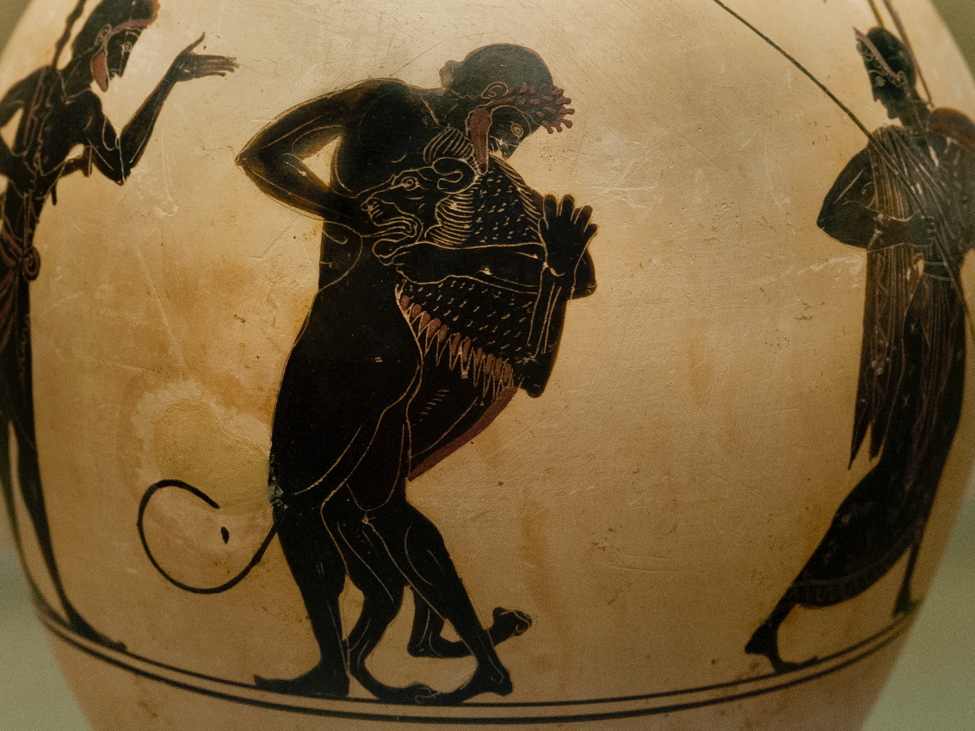
2. The Lernean Hydra
Next, Eurystheus sent Heracles to kill the Hydra. The Hydra was a sea monster (its name comes from hydōr [ὕδωρ], which means “water” in Greek), that had many snake-like heads. The Hydra lived in a swampy area near Lerna, and Heracles came to its den. He engaged the Hydra by grabbing at one of the heads and hacking at it with his sword until the head was severed from the body. But as soon as Heracles had cut off the Hydra’s head, two more heads grew in its place. At this point, Heracles realized that simply cutting off the Hydra’s heads was not going to work. He also realized that he could not kill the Hydra alone, so he called Iolaüs, his charioteer, to bring a burning brand so he could cauterize the neck to prevent new heads from growing back after Heracles cut off each head. Heracles and Iolaüs managed to destroy each head and burn the neck for all the Hydra’s heads until just one head, which was immortal, survived. This head he buried beneath a giant rock. The Hydra’s blood was a deadly poison, so Heracles dipped his arrows in the blood to make sure that anyone he hit would die of his wound. Heracles would one day regret that the Hydra’s blood was so deadly.
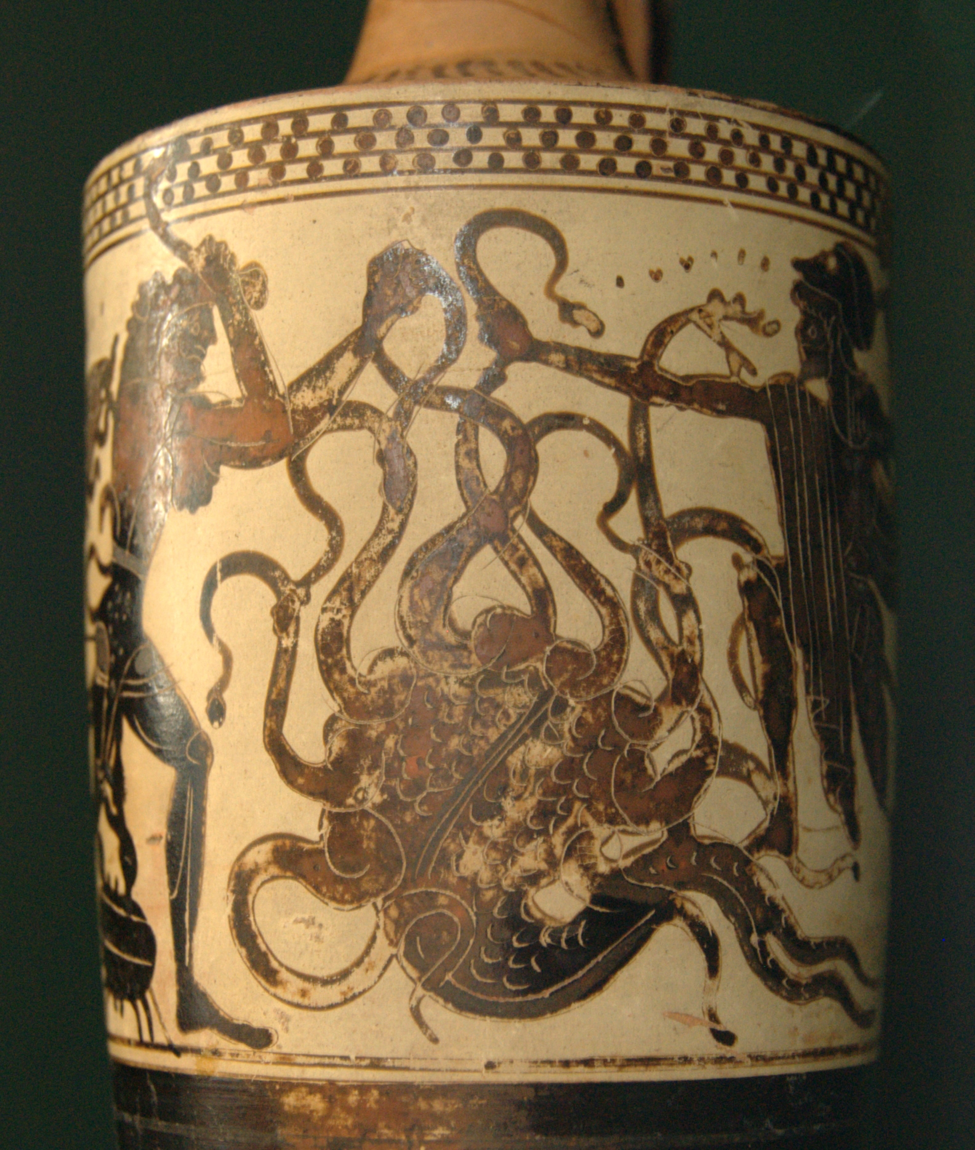
3. Cerynitian Hind
Eurystheus then sent Heracles to capture the Cerynitian Hind, a deer with golden horns that was sacred to the goddess Artemis. Because the deer was sacred to Artemis, Heracles could not kill it; he had to capture it alive. For a year he tracked the deer, which was the fastest deer in the world, around the forests of the Peloponnese. He finally captured it in Arcadia when it had paused for a little rest by creeping up behind it and surprising it. On his way back to Tiryns, Heracles encountered Apollo and Artemis hunting. Artemis was not happy to find her sacred deer so constrained, but after he explained his task, Artemis allowed Heracles to take the deer so long as it remained unharmed and would be released after he was finished with it.
4. Erymanthian Boar
After the Cerynitian Hind had been released, Heracles had to capture the Erymanthian Boar, which was ravaging the countryside around Mount Erymanthus and doing a lot of damage to the crops. On his way to find the Erymanthian Boar, Heracles met Pholus, a centaur who, unlike his fellow centaurs, was quite well mannered. Pholus hosted Heracles like a proper guest and offered him some wine. This wine was noticed by the other centaurs, however, who are notorious for loving wine but also for being unable to hold their liquor. When the centaurs smelled the wine, they went crazy and started attacking Heracles and Pholus in order to steal it. The two successfully drove the centaurs away, but in the process, Pholus dropped one of Heracles’ arrows on his foot and, unfortunately, the Hydra’s poison caused him to die in agony. This is yet another example of Heracles hurting anyone who gets too close to him. In this case it was an accident, but it was no less deadly for Pholus. After this unfortunate incident, Heracles caught up with the Erymanthian Boar and trapped it by driving it into deep snow. He brought the boar back alive to Tiryns to show to Eurystheus. But Eurystheus was so frightened of the enormous beast that he hid in a large storage jar (called a pithos) and only peeked out a little so he could verify that Heracles had completed his task.
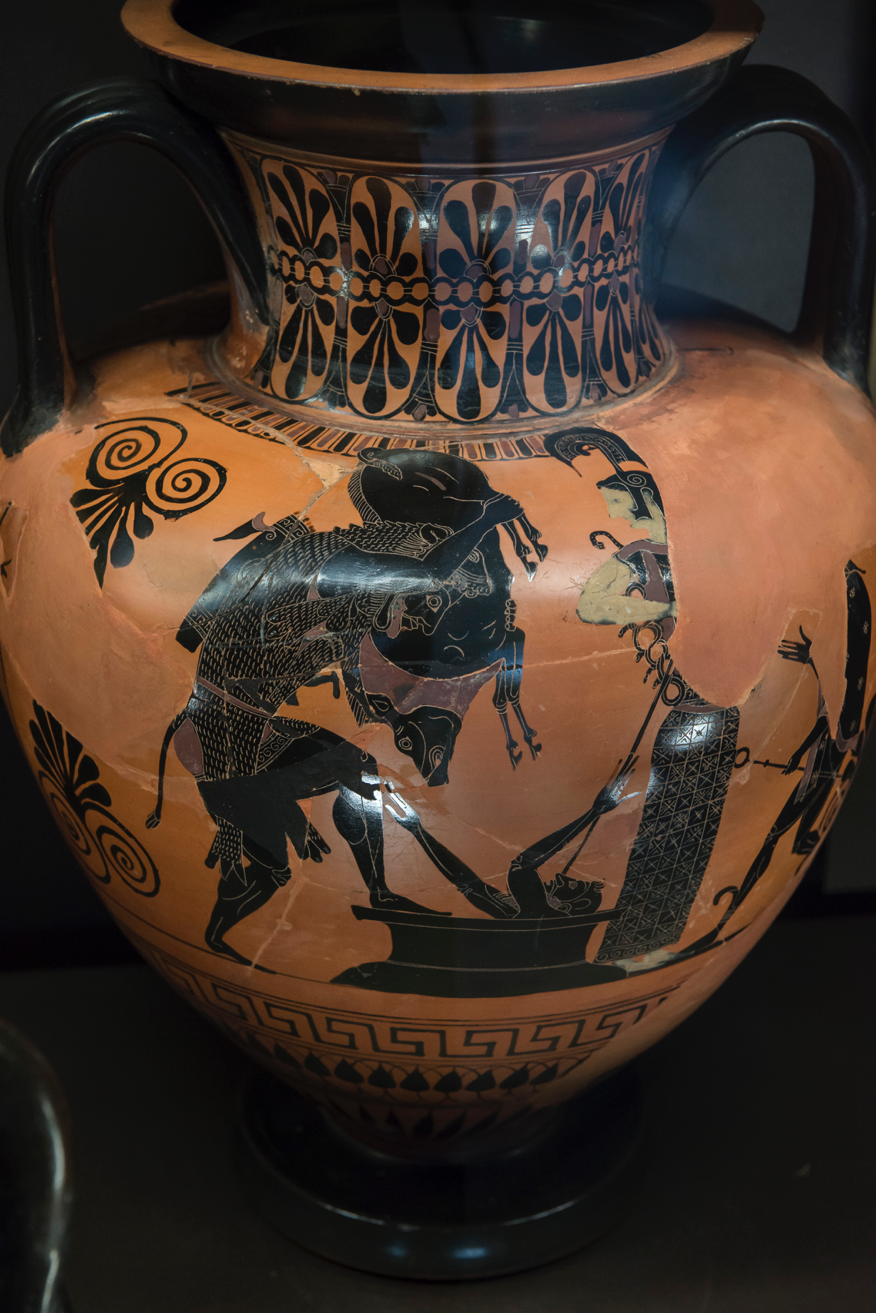
At this point, word had spread throughout Greece that Jason was looking for the greatest Greek heroes to go with him on an expedition for the Golden Fleece. Heracles took a break from his labors to join the crew. However, he did not make the entire journey to Colchis [map] (if he had would there be any use for Jason?). The Argonauts left Heracles behind in Mysia while he searched for his lover Hylas [see Argonauts]. Unable to find Hylas, Heracles returned to Tiryns for his next labor.
5. Augeian Stables
The next task Eurystheus had for Heracles was to clean the Augeian stables in one day. Augeias was king of Elis [map], and he had massive stables that had never been cleaned, so they were filled with many years’ worth of horse dung. Heracles came to Augeias and told him that he could clean out the stables in one day if he paid the right sum: one tenth of his cattle. Augeias agreed, and Heracles set to work. He diverted the courses of two rivers so they flowed right through the stables and washed away the years of filth. Augeias had not believed Heracles could perform the task, so he refused to pay the outrageous sum. Heracles was livid, but at this point there was nothing he could do, so he went back to Tiryns.
6. Stymphalian Birds
Next Heracles was sent to clear away the Stymphalian birds. Lake Stymphalus was overrun by a flock of man-eating birds. Heracles decided that a loud noise would be just the thing, so he crashed a few shields together to scare the birds into taking flight. As the birds flew into the air, he picked them off one by one with his arrows.
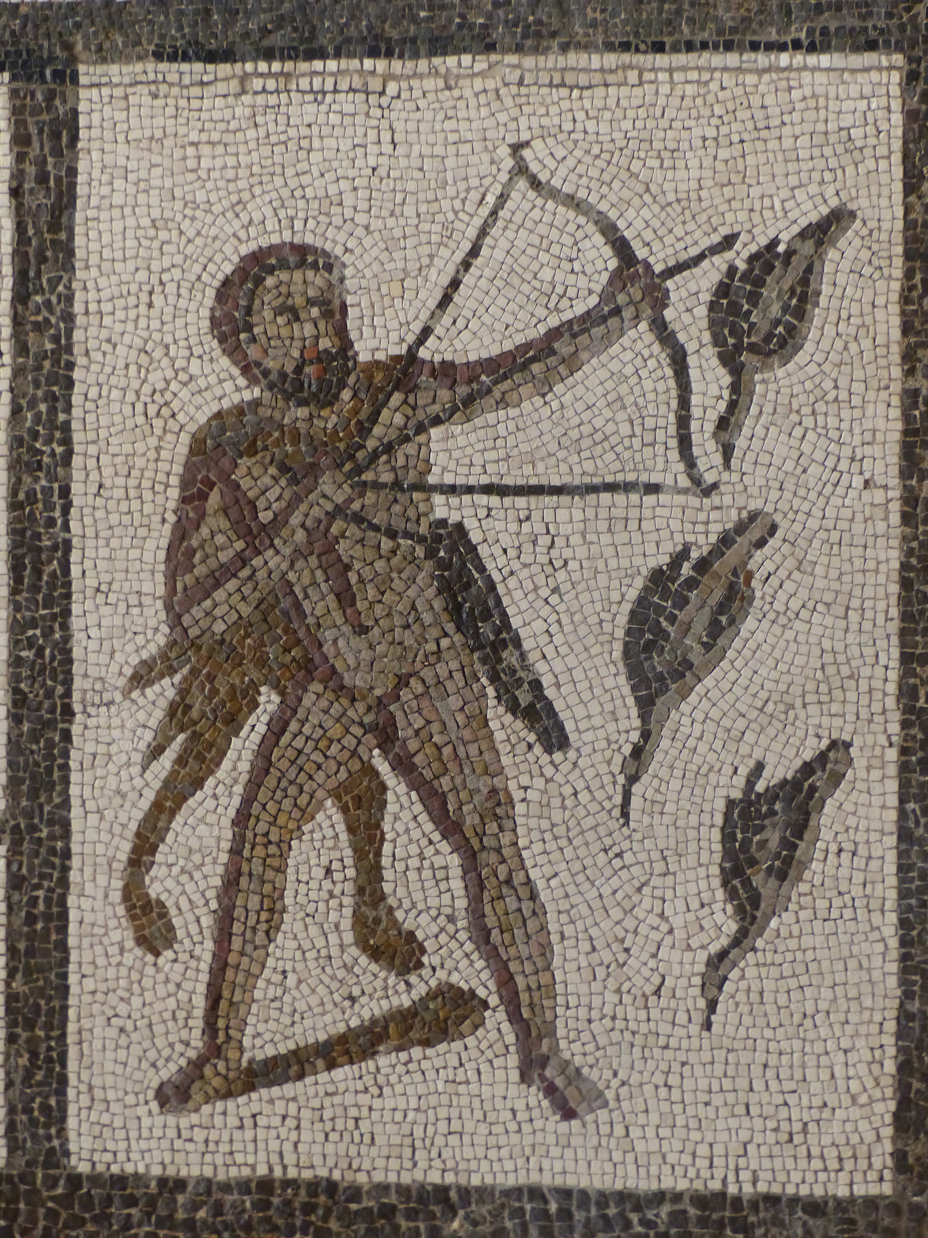
7. The Cretan Bull
Heracles was then sent to capture the Cretan bull. This bull was the father of the Minotaur [see Minotaur], and Heracles trapped it and brought it back to Tiryns alive. Eurystheus did not want it, so Heracles let the bull go. The bull wandered up to the area around Athens [see Athenae on map], and Theseus later killed him as one of his heroic feats [see Theseus].
8. The Mare of Diomedes
The eighth labor required Heracles to retrieve the mares of Diomedes. Diomedes was a Thracian [map] king and he had man-eating mares. Heracles, with the help of his lover Abderus, stole the mares from their stable and herded them down to the seashore. Diomedes’ men were in hot pursuit, so he left Abderus to take care of the mares while he dispatched with Diomedes and routed his men. When Heracles came back, however, he found that the mares had eaten most of Abderus. Heracles was upset at the death of his lover, and he carefully buried Abderus’ remains. He then gathered the mares into his ship and took them back to Eurystheus. Again, Eurystheus did not want the terrible creatures in his city, so Heracles let the mares loose. They were eventually eaten by wild animals as they wandered on Mount Olympus [see Olympus Mons on map].
9. Hippolyte’s Belt
For his next labor, Heracles had to retrieve the belt of the Amazon queen, Hippolyte. Hippolyte and the Amazons (female warriors) lived in Themiscyra on the southern coast of the Black Sea. Heracles was joined on this expedition by his friend Theseus, and they set off together. When they reached Themiscyra, Hippolyte came aboard their ship to meet with them. She agreed to give them her belt with no fight, and everything seemed to be going swimmingly for Heracles and Theseus. However, Hera was not about to allow this labor to be easy, so she came down from Olympus, disguised as an Amazon. Hera told the Amazons that Heracles was kidnapping their queen, and she roused them to fight the heroes. Being angry because he believed the whole thing had been a set-up, Heracles killed Hippolyte and left with Theseus, taking Hippolyte’s sister, Antiope, and the belt. Other versions say that Hippolyte was not killed at all, but that she was the one whom Theseus took with him to Athens, where she became the mother of Theseus’ son Hippolytus [see Theseus].
10. The Cattle of Geryon
Next, Heracles was sent to steal the cattle of Geryon, who was the King of Erytheia (which is modern-day Cadiz in Spain). Geryon had three heads and three upper bodies as well as six arms and six legs. Furthermore, his cattle were guarded by a two-headed watch dog named Orthus. Heracles decided to go through Africa to make his way to Spain, and as he crossed the Strait of Gibraltar, he set up large rocks on either side, called the Pillars of Heracles, to show how far he had come across the world. The sun beat down upon him, greatly annoying Heracles, so he drew his bow and pointed it at the sun, chastising it. Helius, the sun god, was amused by this little stunt, so he lent his golden cup to Heracles to use as a boat to take him the rest of his way to Erytheia. When he arrived, Heracles dispatched of Geryon and Orthus.
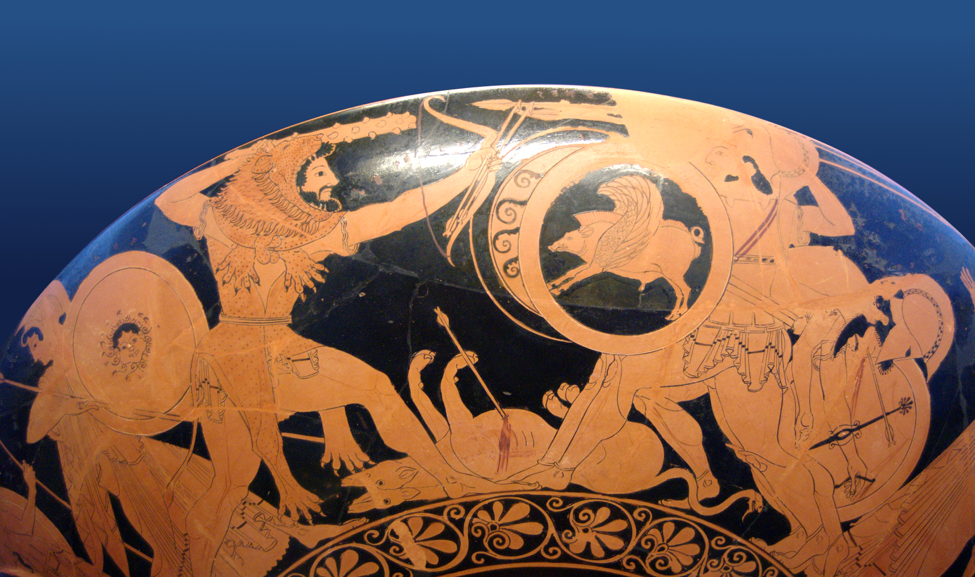
11. The Golden Apples of the Hesperides
Nearly done with his labors, Heracles now went to retrieve the apples of the Hesperides. The Hesperides were nymphs who lived in Libya near the mountains where Atlas held up the world (now called the Atlas Mountains) and tended a garden growing golden apples. On his way there, Heracles passed by the Caucasus Mountains and shot the eagle that had long tortured Prometheus [see Prometheus], freeing him from his bonds. Grateful for his help, Prometheus gave Heracles some advice as to how to retrieve the apples. Prometheus told Heracles to ask Atlas (who happened to be Prometheus’ own brother) to go get the apples. Heracles heeded his advice and asked Atlas to get the apples while he held up the world. Atlas was happy to retrieve the apples, but he had no intention of returning to his post. When he returned with the apples, Atlas offered to take them to Eurystheus for Heracles, intending to never return. But Heracles knew what Atlas was planning. He made a show of agreeing to Atlas’ plan, but he asked the Titan to hold the world just for a minute so he could place a pad on his shoulders to make the task more bearable. Atlas took the world onto his shoulders again, and Heracles picked up the apples and went back to Tiryns. After he had shown them to Eurystheus, he gave them to Athena, and she, in turn, returned them to the Hesperides.
12. Cerberus
Heracles’ final labor was to bring Cerberus back from Hades; of course, he could not kill the three-headed dog in the process. Heracles began this labor by being initiated into the Eleusinian Mysteries. Then Hermes led him down into the Underworld. In Hades, Heracles saw his friends, Theseus and Peirithoüs, stuck to chairs [see Theseus], and they begged Heracles to set them free. Heracles managed to pry Theseus loose and began to move on to Peirithoüs, but the earth began to shake, and Heracles desisted. Heracles and Theseus were allowed to leave, but Hades insisted that Peirithoüs remain. When Heracles came to Hades’ palace, he asked the ruler of the Underworld if he could take Cerberus with him. Hades agreed as long as Heracles did not use weapons to capture him. Heracles grabbed the hell-hound and dragged him all the way to Tiryns. Eurystheus hid as soon as he saw Cerberus, and, from his hiding place, ordered that he be taken back to Hades, and Heracles obliged. With all the labors completed, Heracles was now free to go about his life as he wished. He was also promised that he would become immortal upon his death.
